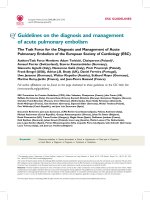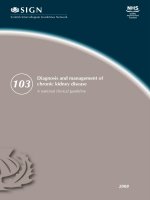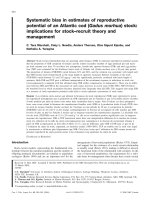ECTOPIC PREGNANCY – MODERN DIAGNOSIS AND MANAGEMENT pptx
Bạn đang xem bản rút gọn của tài liệu. Xem và tải ngay bản đầy đủ của tài liệu tại đây (12.34 MB, 258 trang )
ECTOPIC PREGNANCY –
MODERN DIAGNOSIS
AND MANAGEMENT
Edited by Michael Kamrava
Ectopic Pregnancy – Modern Diagnosis and Management
Edited by Michael Kamrava
Published by InTech
Janeza Trdine 9, 51000 Rijeka, Croatia
Copyright © 2011 InTech
All chapters are Open Access distributed under the Creative Commons Attribution 3.0
license, which permits to copy, distribute, transmit, and adapt the work in any medium,
so long as the original work is properly cited. After this work has been published by
InTech, authors have the right to republish it, in whole or part, in any publication of
which they are the author, and to make other personal use of the work. Any republication,
referencing or personal use of the work must explicitly identify the original source.
As for readers, this license allows users to download, copy and build upon published
chapters even for commercial purposes, as long as the author and publisher are properly
credited, which ensures maximum dissemination and a wider impact of our publications.
Notice
Statements and opinions expressed in the chapters are these of the individual contributors
and not necessarily those of the editors or publisher. No responsibility is accepted for the
accuracy of information contained in the published chapters. The publisher assumes no
responsibility for any damage or injury to persons or property arising out of the use of any
materials, instructions, methods or ideas contained in the book.
Publishing Process Manager Dragana Manestar
Technical Editor Teodora Smiljanic
Cover Designer Jan Hyrat
Image Copyright Julie DeGuia, 2010. Used under license from Shutterstock.com
First published October, 2011
Printed in Croatia
A free online edition of this book is available at www.intechopen.com
Additional hard copies can be obtained from
Ectopic Pregnancy – Modern Diagnosis and Management, Edited by Michael Kamrava
p. cm.
ISBN 978-953-307-648-5
free online editions of InTech
Books and Journals can be found at
www.intechopen.com
Contents
Preface IX
Part 1 Epidemiology, Morbidity and Mortality 1
Chapter 1 Differential Diagnosis of Ectopic
Pregnancy - Morbidity and Mortality 3
Panagiotis Tsikouras, Marina Dimitraki, Alexandros Ammari,
Sofia Bouchlariotou, Stefanos Zervoudis, Panagiotis Oikonomidis,
Constantinos Zakas, Theodoros Mylonas, Anastasios Liberis,
Vasileios Liberis and Georgios Maroulis
Part 2 Causes of Ectopic Pregnancy 11
Chapter 2 Tubal Damage, Infertility and Tubal
Ectopic Pregnancy: Chlamydia trachomatis
and Other Microbial Aetiologies 13
Louise M. Hafner and Elise S. Pelzer
Chapter 3 Ectopic Pregnancy and Assisted Reproductive
Technologies: A Systematic Review 45
Anastasia Velalopoulou, Dimitrios Peschos, Mynbaev Ospan,
Eliseeva Marina, Ioannis Verginadis, Yannis Simos,
Tsirkas Panagiotis, Spyridon Karkabounas, Vicky Kalfakakou,
Angelos Evangelou and Ioannis P. Kosmas
Chapter 4 Hysteroscopic Endometrial Embryo Delivery (HEED) 79
M.M. Kamrava, L. Tran and J.L. Hall
Chapter 5 Ectopic Pregnancy Following Reconstructive,
Organ-Preserving Microsurgery in Tubal Infertility 87
Cordula Schippert, Philipp Soergel
and Guillermo-José Garcia-Rocha
Chapter 6 Persistent Ectopic Pregnancy After Laparoscopic
Linear Salpingostomy for Tubal Pregnancy:
Prevention and Early Detection 97
Shigeo Akira, Takashi Abe and Toshiyuki Takeshita
VI Contents
Part 3 Diagnosis of Ectopic Pregnancy 107
Chapter 7 Management and Outcome of
Ectopic Pregnancy in Developing Countries 109
Buowari Yvonne Dabota
Chapter 8 Clinical Application of One-Step Diagnosis
for Ectopic Pregnancy by HCG Ratio:
Hemoperitoneum Versus Venous Serum 137
Yu-dong Wang, Wei-wei Cheng and Xiao-ping Wan
Chapter 9 Inhibins and Activins
as Possible Marker of Ectopic Pregnancy 151
Blazej Meczekalski and Agnieszka Podfigurna-Stopa
Chapter 10 Term Extra-Uterine Pregnancy 163
Ismail A. Al-Badawi, Osama Al Omar and Togas Tulandi
Part 4 Management of Ectopic Pregnancy 175
Chapter 11 Clinical Treatment of
Unruptured Ectopic Pregnancy 177
Julio Elito Junior
Chapter 12 MTX Could Be First-Line Therapy Even in Cases
Where hCG Level is Greater than 5,000 IU/ml 209
Yoshiki Yamashita, Sousuke Katoh, Yoko Yoshida,
Satoe Fujiwara, Sachiko Kawabe, Mika Hayashi,
Atsushi Hayashi, Yoshito Terai and Masahide Ohmichi
Chapter 13 The Treatment of Ectopic Pregnancy
with Laparoscopy-Assisted Local Injection
of Chemotherapeutic Agents 217
Ching-Hui Chen, Peng-Hui Wang, Li-Hsuan Chiu and Wei-Min Liu
Chapter 14 Fertility-Preserving Surgery for Cervical
Ectopic Pregnancy, from Past to Present 225
Seiryu Kamoi, Nao Iwasaki and Toshiyuki Takeshita
Chapter 15 Modern Management of Cornual Ectopic Pregnancy 237
Maged Shendy and Rami Atalla
Preface
The objective in compiling this book has been to bring more worldwide awareness of
this important cause of maternal morbidity and mortality. In addition to the sexually
transmitted diseases, as advanced reproductive technologies have become available
everywhere, occurrence of ectopic pregnancies has also increased more than before.
With better understanding of the causes of this condition, earlier diagnosis and earlier
treatment of sexually transmitted diseases, along with employing improved
reproductive technologies, has led to more non-invasive treatment options and
improved outcome in the management of these, potentially life-threatening, situations.
This book is dedicated to all our patients from all over the world who have given us
the impetus for giving them hope for having a family. Also, I would like to thank my
wife, Soheila, and our children Mitchell and Michelle for their patience, understanding
and encouragement in taking on this task.
Michael Kamrava, MD
West Coast IVF Clinic, Inc.
LA Center for Embryo Implantation (SEED/ HEED)
USA
Part 1
Epidemiology, Morbidity and Mortality
1
Differential Diagnosis of Ectopic Pregnancy
- Morbidity and Mortality
Panagiotis Tsikouras et al.,
*
Department of Obstetrics and Gynecology , Democritus University of Thrace
Greece
1. Introduction
The term ectopic pregnancy refers to a gestation in which the fertilized ovum implants on
any tissue other than the endometrial membrane lining the uterine cavity. Fig 1 presents the
various types of ectopic pregnancy and their relative frequencies The classic clinical
symptoms of ectopic pregnancy are pelvic pain, amenorrhea, and vaginal bleeding , spotting
(40-50%). However, only 50% of patients present typical symptomatology. Patients may
present with other symptoms common to early pregnancy, including nausea (frequently
after rupture), breast fullness, fatigue, abdominal pain, heavy cramping, shoulder pain, and
recent dyspareunia . Physical findings during examination should be pelvic unilateral
tenderness, especially on movement of cervix (75%), enlarged uterus or palpable adnexal
mass; crepitant mass on one side or in culde-sac (50%). Approximately 20% of patients with
ectopic pregnancies are hemodynamically compromised at initial presentation, which is
highly suggestive of rupture. Body temperature ranges from 37.2 to 37.8
0
C while the pulse
is variable: normal before but rapid after rupture. Today, using modern diagnostic
techniques, most ectopic pregnancies may be diagnosed prior to rupturing [1].
Diagnosis of ectopic pregnancy has been greatly improved by the advent of rapid serum
beta-human chorionic gonadotropin (beta-HCG) tests and then the widespread adoption of
transvaginal pelvic ultrasonography (TVUS) [2].
Serum beta-HCG levels can definitively rule out pregnancy if negative, although there have
been case reports of pathology-proven ruptured ectopic pregnancy and hemorrhagic shock
despite an undetectable serum beta-HCG [3].
In the early stages of a normal intrauterine
pregnancy (IUP), the serum beta-HCG rises along a well-defined curve. Therefore, serial
beta-HCG tests can be useful for determining the ultimate location of a pregnancy of
unknown location. The lower limit of normal rise in beta-HCG (using a 99% confidence
interval) is 53% in 2 days [4].
Patients with a beta-HCG level that falls more than 50% in 2
*
Marina Dimitraki
1
, Alexandros Ammari
1
, Sofia Bouchlariotou
1
, Stefanos Zervoudis
2
,
Panagiotis Oikonomidis
2
, Constantinos Zakas
2
, Theodoros Mylonas
1
, Anastasios Liberis
1
,
Vasileios Liberis
1
and Georgios Maroulis
1
1
Department of Obstetrics and Gynecology , Democritus University of Thrace, Greece
2
Department of Obstetrics and Gynecology, Rhea Hospital, Athens, Greece
Ectopic Pregnancy – Modern Diagnosis and Management
4
days are at low risk of having an ectopic pregnancy [5].As ruptured ectopic pregnancies
have been reported at a wide range of beta-HCG levels, the beta-HCG level should not be a
factor in determining whether or not transvaginal ultrasonography should be performed.
(The prevalence of false-positive serum hCG results is low, with estimates ranging from
0.01-2%. False-positive serum hCG results are usually due to interference by non-hCG
substances or the detection of pituitary hCG. Some examples of non-hCG substances that
can cause false-positive results include human LH, antianimal immunoglobulin antibodies,
rheumatoid factor, heterophile antibodies, and binding proteins. Most false-positive results
are characterized by serum levels that are generally less than 1000 mIU/mL and usually less
than 150 mIU/mL[6].)
Fig 1. Various types of ectopic pregnancy and their relative frequencies
Serum progesterone levels tend to be stable over time during the first trimester and
concentrations are higher in normal intrauterine pregnancy. A single serum progesterone
level has been used alone to discriminate between normal and failing intrauterine
pregnancies, but it cannot accurately discriminate between intrauterine and ectopic
pregnancies [7]. Levels of <5ng/ml are associated with a viable pregnancy in 0.16% of cases .
Low progesterone levels in combination hCG levels is “essentially 100% predictive of
awith an abnormal rise in nonviable pregnancy” (intra or extrauterine) . A progesterone
level of less than 15 ng/ml is seen in: 81% of ectopics, 93% of abnormal intrauterine
pregnancies, 11% of normal intrauterine pregnancies [8].
The human chorionic gonadotropin (hCG) ratio of hemoperitoneum to venous serum (R
P/V
)
has been demonstrated to improve early diagnosis of ectopic pregnancy, according to a
recent study. Investigators observed that the R
P/V
was higher in ectopic pregnant subjects
(median 4.07) than in patients with hemoperitoneum and intrauterine pregnancy (hIUP;
median 0.6), with 1.0 as their suggested threshold value for differential diagnosis [9].
Differential Diagnosis of Ectopic Pregnancy - Morbidity and Mortality
5
Research is ongoing concerning CA 125, pregnancy-associated plasma protein-A, vascular
endothelial growth factor and creatine kinase. None of them have yet shown superiority to
serial beta-HCG measurements in distinguishing between intrauterine pregnancy and
ectopic pregnancy [10].
Furthermore , pelvic sonography is the imaging test of choice to investigate early pregnancy
complaints. As sonogram findings of early normal IUP development (<7 weeks) are well
correlated with beta-HCG level, the absence of a normal IUP on sonogram together with a
beta-HCG level above the discriminatory zone virtually rules out a normal IUP.
Pelvic sonography is usually conducted first using the transabdominal approach (which can
reliably identify intrauterine pregnancies at a beta-HCG level above 6500 mIU/mL), and
then the transvaginal approach (which can extend the discriminatory zone down to 1500
mIU/mL). M-mode imaging is useful for measuring the fetal heart rate. Color Doppler
ultrasonography can help identify some ectopic pregnancies by identifying a placental
blood flow pattern in the adnexa. Τhe following sonographic findings are of special interest :
An intrauterine gestational sac containing a yolk sac, or fetal pole: A definitive IUP virtually
rules out ectopic pregnancy (aside from heterotopic pregnancies). An intrauterine
gestational sac larger than 16 mm without a fetal pole, or larger than 8 mm without a yolk
sac; or an intrauterine fetal pole larger than 5 mm without heart motion: These findings are
indicative of failed intrauterine pregnancy. A gestational sac with a mean sac diameter less
than 5 mm greater than the crown-rump length has an 80% risk of pregnancy loss [11]. An
extrauterine sac containing a yolk sac or a fetal pole, with or without heart motion Fig 2:
Although definitive for ectopic pregnancy, only 16-32% of ectopics have this finding on
transvaginal sonogram [12].
Fig. 2. Vaginal Ultrasound showing gestational sac with yolk sac in extra uterine location.
Ectopic Pregnancy – Modern Diagnosis and Management
6
Tubal ring is a thick-walled cystic structure in the adnexa, independent of the ovary and
uterus, and is highly predictive of ectopic pregnancy [13].
It can sometimes be confused with
a corpus luteum cyst when the ovary is not well visualized. The corpus luteum cyst wall
tends to be thinner and less echogenic than the endometrium and the cyst tends to contain
clear fluid [14].
When surrounded by free fluid, it can sometimes be confused with a
hemorrhagic ovarian cyst [15].
A complex adnexal mass is the sign most frequently found in
ectopic pregnancies [16].
It can be somewhat cystic-appearing or entirely solid in nature,
surrounded by free fluid, and ill-defined. If it cannot be moved independently of the ovary,
it is unlikely to be an ectopic pregnancy [17].
A moderate amount of anechoic free fluid
(tracking more than one third of the way up the posterior wall of the uterus), or any
echogenic free fluid, has a higher chance of being ultimately diagnosed as an ectopic
pregnancy [18].
Culdocentesis is the transvaginal needle aspiration of fluid from the posterior cul-de-sac of
Douglas. A positive result means aspiration of 0.5 ml of nonclotting blood, while negative
result is accociated with aspiration of 0.5 ml of serous fluid If no fluid is aspirated ,the test
is inadequate. In positive cases ,if the hematocrit of aspirated fluid is over 15%, ruptured
ectopic pregnancy is possible ,while a hematocrit of aspirated fluid below 15% is usually in
favor of other causes of intraabdominal hemorrhage, such as hemorrhagic corpus luteum
cyst, tubal reflux of intrauterine blood , previous attempt at culdocentesis or(19-21). A
positive culdocentesis is found in 70-90% of cases in ectopic pregnancy. A positive
culdocentesis indicates the presence of a hemoperitoneum ,(21) but does not give the source
of the blood and does not necessarily indicate tubal rupture .The volume of blood recovered
does not correlate with the volume of the hemoperitoneum. A positive culdocentesis test in
combination with a positive pregnancy test predicts the presence of an ectopic pregnancy, in
approximately 95% of cases. (22-3) However double decidual sac sign, or gestational sac <8
mm without yolk sac or fetal pole is in favor of the diagnosis of ectopic pregnancy. While
considered diagnostic of IUP by experienced sonographers, this can be easily confused with
the pseudogestational sac found in ectopic pregnancy (caused by breakdown of stimulated
endometrial lining) and lead to falsely ruling out of ectopic pregnancy [12].
The
pseudogestational sac (seen in 10-20% of ectopic pregnancies [24] can be differentiated by its
central location in the uterus, oval shape, thin echogenic rim, and lack of double decidual
sac sign [11].
A thin endometrial stripe (<8 mm) appears to be somewhat predictive of
eventual diagnosis of ectopic pregnancy in patients with a beta-HCG below 1,000 mIU/Ml
[25]
but there is sufficient overlap with eventual failed IUPs and normal IUPs that this is a
poor diagnostic test [26]
.
Numerous conditions may have a presentation similar to an extrauterine pregnancy (EP).
The most common differential diagnosis hemmoragic are: a ruptured corpus luteum cyst or
ovarian follicle (RC), and a spontaneous abortion or threatened abortion (SA). Other
differential diagnosis are appendicitis (A), salpingitis(S), ovarian torsion(OT), and urinary
tract disease(UD): cystitis, ureteric colic. Intrauterine pregnancies with other abdominal or
pelvic problems such as degenerating fibroids must also be included in the differential
diagnosis.
Specifically, differential diagnosis of ectopic pregnancy includes : Miscarriage (Includes
anembryonic gestation, threatened abortion, incomplete abortion, complete abortion, missed
abortion.) Often presents with vaginal bleeding in the first trimester, accompanied by
abdominal discomfort secondary to uterine contractions. History may yield disappearance
of pregnancy symptoms such as breast tenderness and nausea. Ultrasound shows
Differential Diagnosis of Ectopic Pregnancy - Morbidity and Mortality
7
intrauterine pregnancy or products of conception. Pelvic examination may note dilation of
the cervix, as well as presence of tissue at the cervical os. Consecutive serum chorionic
gonadotrophin levels often do not rise appropriately (66% in 48 hours), and progesterone
levels often <15.9 nmol/L (<5 ng/mL). Acute appendicitis: Anorexia and periumbilical pain
followed by nausea, RLQ (Right Lower Quadrant) abdominal pain, tenderness localizing at
Mc Burney' s point; rebound tenderness and vomiting usual , precedes shift of pain to right
lower quadrant. Vaginal bleeding in appendicitis occur unrelated to menses , temperature is
37.2-37.8 C and pulse are variable. No masses founded by pelvic examination. Ultrasound
sensitivity of 85% to 90% and specificity of 92% to 96%; may show appendix with outer
diameter >6 mm, no compressibility, lack of peristalsis, or periappendiceal fluid. WBC
>10,000 cells/ μl ( rarely normal) ;red cell count normal; sedimentation rate slightly
elevated. Ovarian torsion: Sudden onset, severe, unilateral lower abdominal pain that
worsens intermittently over many hours. Peritoneal signs are often absent. Ovarian
enlargement secondary to impaired venous and lymphatic drainage is the most common
sonographical finding in ovarian torsion. Absence of arterial blood flow may also be used
for diagnostic purposes, but this is often absent in the early stages of torsion. PID (pelvic
inflammatory disease) or tubo-ovarian abscess: Lower abdominal tenderness on palpation,
pain usally in both lower quadrants, with or without rebound, adnexal tenderness, adnexal
masses only when pyosalpinx or hydrosalpinx is present and cervical motion tenderness.
May also have body temperature >38.4°C?[ MORE THAN 38 ] and abnormal cervical or
vaginal discharge. Occurrence of hypermenorrhea or metrorrhagia or both. Nausea and
vomiting are infrequent . Although rare in pregnancy, can occur in the first 12 weeks of
gestation before the decidua seals off the uterus from ascending bacteria. WBC often >10,000
cells/mm
3
; red cell count normal; sedimentation rate normal. Ultrasound not used in
uncomplicated PID, but is a valuable adjunct in diagnosis of tubo-ovarian abscess. Ruptured
corpus luteal cyst or follicle : Non-specific nausea, vomiting, low fever, and pelvic pain,
which is often sharp, intermittent, sudden in onset, and severe unilateral ,becoming general
with progressive bleeding. At times the ruptured cyst may lead to profuse bleeding and
result in haemorrhagic shock. Period delayed, then bleeding , often with pain. Temperature
not over 37.2 ; pulse normal unless blood loss marked, then rapid. Laboratory findings :
white cell count normal to 10.000 /μl ; red cell count normal ; sedimentation normal.
Doppler ultrasonography usually diagnostic, especially when transvaginal and
transabdominal modalities are used together. Nephrolithiasis: Classically writhing in pain,
pacing about, and unable to lie still, in contrast to a patient with peritoneal irritation, who
remains motionless to minimise discomfort. Often presents with unilateral or bilateral flank
pain. Haematuria (presence of >1 RBC/hpf) and pyuria (>5 WBC/hpf on a centrifuged
specimen) common. Due to potential risks to the fetus, the only imaging modalities used in
pregnant women are ultrasonography (direct visualisation of the stone, hydroureter > 6 mm
in diameter, and perirenal urinoma suggesting calyceal rupture) and MRI (if ultrasound is
non-diagnostic). UTI (urinary tract disease): Dysuria with accompanying urinary urgency,
frequency, and abdominal discomfort along the surface of the bladder. May have pyuria (>5
WBC/hpf on a centrifuged specimen). Presence of nitrites is highly specific for a UTI, but its
absence should not exclude the diagnosis.
Finally , bowel colitis ,inguinal or crural hernia and muscular pain should be included in the
differential diagnosis of abdominal pain in lower quadrants.
Ectopic pregnancy is responsible for a significant proportion of maternal mortality and
morbidity. According to the WHO, ectopic pregnancy accounts for 0.1 to 4.9% of the total
Ectopic Pregnancy – Modern Diagnosis and Management
8
maternal deaths worldwide. [27] The range varies in different regions of the world,
exhibiting the highest prevalence in developed countries. Table 1 . [27] It should be
mentioned at this point that in developing countries, hemorrhage is the leading cause of
maternal deaths.
It is responsible for an enormous amount of hospital admissions, surgical interventions and
blood transfusions worldwide.
The mortality rate has declined from 35.5 maternal deaths per 10,000 ectopic pregnancies in
1970 to only 3.8 maternal deaths per 10,000 ectopic pregnancies in 1989. [28]Mortality from
ectopic pregnancy is the commonest cause of maternal death, replacing mortality resulting
from illegal abortion. [29]
World Region Percentage (%)
Asia 0.1
Africa 0.5
Latin America 0.5
Developed countries 4.9
Table 1. Variability of maternal deaths due to ectopic pregnancy in different regions of the
world.
Studies have shown that African-American women have a mortality ratio 3 to 18 times
higher than white women [29-30]
Delay of treatment and misdiagnosis are the main factors that lead to mortality.
Approximately 50 percent of ectopic pregnancies are misdiagnosed at the initial visit to an
emergency department. [31-2]
The significant fall of maternal mortality is due to modern diagnostic advances and
minimally invasive treatments.
2. References
[1] Vicken PS., Wood E, Ectopic Pregnancy, emedicine.medscape.com Updated: Mar 8, 2011
[2] Cohen HL, Moore WH. History of emergency ultrasound. J Ultrasound Med. Apr
2004;23(4):451-8.
[3] Grynberg M, Teyssedre J, Andre C, Graesslin O. Rupture of ectopic pregnancy with
negative serum beta-hCG leading to hemorrhagic shock. Obstet Gynecol. Feb
2009;113(2 Pt 2):537-9.
[4] Barnhart KT, Sammel MD, Rinaudo PF, Zhou L, Hummel AC, Guo W. Symptomatic
patients with an early viable intrauterine pregnancy: HCG curves redefined. Obstet
Gynecol. Jul 2004;104(1):50-5.
[5] Dart RG, Mitterando J, Dart LM. Rate of change of serial beta-human chorionic
gonadotropin values as a predictor of ectopic pregnancy in patients with
indeterminate transvaginal ultrasound findings. Ann Emerg Med. Dec
1999;34(6):703-10.
[6] Ackerman R, Deutsch S, Krumholz B. Levels of human chorionic gonadotropin in
unruptured and ruptured ectopic pregnancy. Obstet Gynecol 1982;60:13-14.
Differential Diagnosis of Ectopic Pregnancy - Morbidity and Mortality
9
[7] Mol BW, Lijmer JG, Ankum WM, van der Veen F, Bossuyt PM. The accuracy of single
serum progesterone measurement in the diagnosis of ectopic pregnancy: a meta-
analysis. Hum Reprod. Nov 1998;13(11):3220-7.
[8] Lipscomb GH, Stovall TG, Ling FW. Non surgical treatment of ectopic pregnancy. NEJM
200;343(18):1325-1329
[9] Wang Y, Zhao H, Teng Y, Lu L, Tong J. Human chorionic gonadotropin ratio of
hemoperitoneum versus venous serum improves early diagnosis of ectopic
pregnancy. Fertil Steril. 2008 .
[10] Cabar FR, Fettback PB, Pereira PP, Zugaib M. Serum markers in the diagnosis of tubal
pregnancy. Clinics (Sao Paulo). Oct 2008;63(5):701-8.
[11] Dighe M, Cuevas C, Moshiri M, Dubinsky T, Dogra VS. Sonography in first trimester
bleeding. J Clin Ultrasound. Jul-Aug 2008;36(6):352-66.
[12] Patel MD. "Rule out ectopic": Asking the right questions, getting the right answers.
Ultrasound Q. Jun 2006;22(2):87-100.
[13] Brown DL, Doubilet PM. Transvaginal sonography for diagnosing ectopic pregnancy:
positivity criteria and performance characteristics. J Ultrasound Med. Apr
1994;13(4):259-66.
[14] Stein MW, Ricci ZJ, Novak L, Roberts JH, Koenigsberg M. Sonographic comparison of
the tubal ring of ectopic pregnancy with the corpus luteum. J Ultrasound Med. Jan
2004;23(1):57-62.
[15] Hertzberg BS, Kliewer MA, Bowie JD. Adnexal ring sign and hemoperitoneum caused
by hemorrhagic ovarian cyst: pitfall in the sonographic diagnosis of ectopic
pregnancy. AJR Am J Roentgenol. Nov 1999;173(5):1301-2.
[16] Frates MC, Brown DL, Doubilet PM, Hornstein MD. Tubal rupture in patients with
ectopic pregnancy: diagnosis with transvaginal US. Radiology. Jun 1994;191(3):769-
72.
[17] Blaivas M. Color doppler in the diagnosis of ectopic pregnancy in the emergency
department: is there anything beyond a mass and fluid?. J Emerg Med. May
2002;22(4):379-84.
[18] Dart R, McLean SA, Dart L. Isolated fluid in the cul-de-sac: how well does it predict
ectopic pregnancy?. Am J Emerg Med. Jan 2002;20(1):1-4.
[19] Glezerman M, Press F, Carpman M. Culdocentesis is an obsolete diagnostic tool in
suspected ectopic pregnancy.Arch Gynecol Obstet. 1992;252(1):5-9
[20] Wyte CD.Diagnostic modalities in the pregnant patient. Emerg Med Clin North Am.
1994 Feb;12(1):9-43. Review
Cartwright PS, Vaughn B, Tuttle D. Culdocentesis and ectopic pregnancy. J Reprod
Med. 1984 Feb;29(2):88-91.
[21] Falfoul A, Makni MY, Bellasfar M, Tnani M, Kaabar N, Kharouf M. [The role of
culdocentesis in the diagnosis of ectopic pregnancy. Prospective study of 478
cases].J Gynecol Obstet Biol Reprod (Paris). 1991;20(7):917-22. French.
[22] Romero R, Copel JA, Kadar N, Jeanty P, Decherney A Hobbins JC. Value of
culdocentesis in the diagnosis of ectopic pregnancy.Obstet Gynecol. 1985
Apr;65(4):519-22
[23] Nyberg DA, Laing FC, Filly RA, Uri-Simmons M, Jeffrey RB Jr. Ultrasonographic
differentiation of the gestational sac of early intrauterine pregnancy
from the
pseudogestational sac of ectopic pregnancy. Radiology. Mar 1983;146(3):755-9.
Ectopic Pregnancy – Modern Diagnosis and Management
10
[24] Dart RG, Dart L, Mitchell P, Berty C. The predictive value of endometrial stripe
thickness in patients with suspected ectopic pregnancy who have an empty uterus
at ultrasonography. Acad Emerg Med. Jun 1999;6(6):602-8.
[25] Seeber B, Sammel M, Zhou L, Hummel A, Barnhart KT. Endometrial stripe thickness
and pregnancy outcome in first-trimester pregnancies with bleeding, pain or both. J
Reprod Med. Sep 2007;52(9):757-61.
Khan KS, Wojdyla D, Say L, Gülmezoglu AM, Van Look PF. WHO analysis of
causes of maternal death: a systematic review. Lancet. 2006 Apr 1;367(9516):1066-
74. Review.
[26] Goldner TE, Lawson HW, Xia Z, Atrash HK. Surveillance for ectopic pregnancy United
States, 1970-1989. MMWR CDC Surveill Summ 1993.
[27] Dorfman SF. Epidemiology of ectopic pregnancy. Clin Obstet Gynecol. 1987 Mar;30(1):
173-80.
[28] Anderson FW, Hogan JG, Ansbacher R. Sudden death: ectopic pregnancy mortality.
Obstet Gynecol. 2004 Jun;103(6):1218-23.
[29] Abbott J, Emmans LS, Lowenstein SR. Ectopic pregnancy: ten common pitfalls in
diagnosis. Am J Emerg Med 1990;8:515-22.
[30] Kaplan BC, Dart RG, Moskos M, Kuligowska E, Chun B, Adel Hamid M, et al. Ectopic
pregnancy: prospective study with improved diagnostic accuracy. Ann Emerg Med
1996;28:10-7.
Part 2
Causes of Ectopic Pregnancy
2
Tubal Damage, Infertility and Tubal Ectopic
Pregnancy: Chlamydia trachomatis and
Other Microbial Aetiologies
Louise M. Hafner and Elise S. Pelzer
Institute of Health and Biomedical Innovation, (IHBI),
Queensland University of Technology (QUT)
Australia
1. Introduction
Infertility is a worldwide health problem with one in six couples suffering from this
condition and with a major economic burden on the global healthcare industry. Estimates of
the current global infertility rate suggest that 15% of couples are infertile (Zegers-
Hochschild et al., 2009) defined as: (1) failure to conceive after one year of unprotected
sexual intercourse (i.e. infertility); (2) continual failure of implantation at subsequent cycles
of assisted reproductive technology; or (3) persistent miscarriage events without difficulty
conceiving (natural conceptions). Tubal factor infertility is among the leading causes of
female factor infertility accounting for 7-9.8% of all female factor infertilities. Tubal disease
directly causes from 36% to 85% of all cases of female factor infertility in developed and
developing nations respectively and is associated with polymicrobial aetiologies. One of the
leading global causes of tubal factor infertility is thought to be symptomatic (and
asymptomatic in up to 70% cases) infection of the female reproductive tract with the
sexually transmitted pathogen, Chlamydia trachomatis. Infection-related damage to the
Fallopian tubes caused by Chlamydia accounts for more than 70% of cases of infertility in
women from developing nations such as sub-Saharan Africa (Sharma et al., 2009). Bacterial
vaginosis, a condition associated with increased transmission of sexually transmitted
infections including those caused by Neisseria gonorrhoeae and Mycoplasma genitalium is
present in two thirds of women with pelvic inflammatory disease (PID). This review will
focus on (1) the polymicrobial aetiologies of tubal factor infertility and (2) studies involved
in screening for, and treatment and control of, Chlamydial infection to prevent PID and the
associated sequelae of Fallopian tube inflammation that may lead to infertility and ectopic
pregnancy.
2. Tubal factor infertility
In the absence of functional Fallopian tubes, couples may only conceive through in vitro
fertilisation procedures. Women with tubal factor infertility may be defined as women who
have either (1) damaged/occluded Fallopian tubes or (2) have history of salpingectomy.
Ectopic pregnancy is only relevant if the Fallopian tubes remain in situ. Previous studies
Ectopic Pregnancy – Modern Diagnosis and Management
14
have concluded that salpingitis can accompany early intrauterine pregnancy, often with
significant foetal loss (Lara-Torre & Pinkerton 2002; Yip et al., 1993) but that upper genital
tract infections do not always result in poor reproductive health outcomes (den Hartog et al.,
2006). PID, which is diagnosed in greater than 800,000 women each year in the United States
is associated with Fallopian tube inflammation, which can lead to tubal factor infertility in
women ranging from 5.8% and 60%, depending upon the microbial aetiology of disease and
the number of recurrent infections (Soper, 2010; Westrom, 1980). A recent estimate, not
including women with ‘silent salpingitis’ or asymptomatic infections was that the annual
cost of caring for women with PID is US $2 billion (Soper, 2010). PID is known to be caused
by the sexually transmitted microorganisms C. trachomatis, N. gonorrhoeae, and M. genitalium
as well as bacterial vaginosis-associated microorganisms consisting predominantly of
anaerobic Gram-negative bacilli. Investigations into the levels of antimicrobial compounds
in Fallopian tubes or antibodies in sera collected from women with ectopic pregnancy,
suggest that immune responses to infectious agents may also predispose for this condition
(Refaat et al., 2009; Srivastava et al., 2008).
3. Fallopian tube function
The Fallopian tube plays an essential role in gamete and zygote transport. In parallel with
the endometrium, the Fallopian tube also undergoes cyclical changes in response to the
steroid hormones oestradiol and progesterone, which alter morphology and the frequency
of beating of the ciliary (Critoph and Dennis, 1977a).
The transport of gametes and embryos through the Fallopian tubes relies on contractions of
the tubal musculature, ciliary activity and the flow of tubal secretions (Jansen, 1984).
Distortions of the luminal architecture of the Fallopian tubes have been associated with
tubal ectopic pregnancy, predominantly because of failure of the transport mechanisms to
move the gametes/embryos through the tube and into the uterus prior to implantation
(Mast, 1999). Microbial infection of the Fallopian tubes is one reason for alterations in the
tubal epithelial lining. Tubal disease resulting in infertility is the result of an inflammatory
process in or around the Fallopian tube (Mastroianni, 1999). The extent of tubal damage is
dependent on the severity and duration of the infection. The disease spectrum ranges from
complete tubal occlusion with hydrosalpinx to mild intraluminal adhesions (Mastroianni,
1999).
3.1 Ovulation and oocyte capture
After ovulation, follicular fluid is the major constituent of the Fallopian tube secretions. The
overall composition and viscosity of the tubal secretions (including elevated levels of steroid
hormones and prostaglandins) enhances the ciliary beat frequency (Blandau et al., 1975).
Ciliary beat frequency is different for each part of the Fallopian tube. Elevations in the
progesterone concentration in tubal secretions result in a slowing of the ciliary beat to allow
fertilisation to occur, however, if the progesterone levels are too high then deciliation occurs
and the prolonged delay in ciliary beat may result in implantation of the embryo within the
Fallopian tube mucosa (Diaz et al., 1980).
Prostaglandins within the follicular fluid mix with the tubal secretions and also increase the
contractility of the fimbriae and the tubo-ovarian ligaments (Morikawa et al., 1980). A
controlled, deliberate movement of the tubal fimbriae ensues, initiating contact between the
Tubal Damage, Infertility and Tubal Ectopic Pregnancy:
Chlamydia trachomatis and Other Microbial Aetiologies
15
point of ovulation and the cumulus-oocyte-complex gently propelling the ovulated oocyte
into the Fallopian tube toward the uterus (Lindblom & Andersson 1985). Transportation of
the oocyte and then following fertilisation, the embryo, through the Fallopian tubes takes
approximately 80 hours (Croxatto et al., 1972; Croxatto et al., 1978). Inhibition of oocyte
capture by the Fallopian tube may result from microbial infections of the tube. The
subsequent immune response can form adhesions on the fimbrial end of the Fallopian tubes
or cause altered pelvic anatomy, which prevents the physical movement of the tube.
3.2 Steroid hormones (oestradiol and progesterone)
The Fallopian tubes undergo cyclical changes under the influence of the steroid hormones,
oestradiol and progesterone (Critoph & Dennis, 1977) and Fallopian tube steroid hormone
receptors are expressed in response to the ovulatory cycle (Pollow et al., 1981). Changes in
the steroid hormone expression within the Fallopian tube contribute to successful transport
and ultimately implantation (Horne et al., 2009).
Progesterone has an inhibitory effect in ciliary movement and tubal smooth muscle
contractility, resulting in a reduction in contraction frequency (Paltieli et al., 2000) and ciliary
beat (Wanggren et al., 2008), capable of causing delayed transport of the embryo and ectopic
implantation. Horne et al., (2009) reported a reduced expression of progesterone receptors in
the Fallopian tubes of women with previous tubal ectopic pregnancies. They were also
unable to detect expression of an oestrogen receptor on the Fallopian tubes from these same
women when compared to Fallopian tubes from non-pregnant women. The alterations in
steroid hormone expression in response to the ovulatory cycle were discordant in non-
pregnant women, compared with those reported in women with tubal ectopic pregnancies
(Horne et al., 2009).
The oestrogen receptor is reportedly a dominant regulator of normal Fallopian tube
development (Mowa & Iwanaga 2000) however; expression of the oestrogen receptor
remains constant throughout the ovulatory cycle (Horne et al., 2009).
Previous investigations have assessed the effect of oral contraceptives on the risk of ectopic
pregnancy. The inhibition of fertilisation or ovulation resulted in a decreased incidence of
ectopic pregnancy in women with vasectomised male partners, and in women prescribed
combined oral contraceptives. In contrast, the incidence of ectopic pregnancy was elevated
in women using progesterone only contraceptives, and highest in those women using
progesterone only contraceptive and an intra-uterine device (Franks et al., 1990). This may
be due to the effect of progesterone on ciliary beat frequency or in the case of an intra-
uterine device; there is an increased risk of ascending infection by commensal microflora.
Finally, the steroid hormones oestradiol and progesterone are growth factors or inhibitors
for various microbial species. It has been suggested that the more frequent diagnosis of
specific genital tract infections at various stages of the menstrual cycle is due to the
concentrations of each of these hormones (Sonnex, 1998).
3.3 Salpingitis and alterations to the Fallopian tube luminal epithelium
The most frequent cause of ectopic pregnancy is previous salpingitis (Lehner et al., 2000).
The predominant facultative pathogens identified in tubal fluid from women with
salpingitis are coliform bacteria (Holmes et al., 1980; Ledger et al., 1994; Swenson et al., 1974)
and the predominant anaerobic species originate from the Bacteroides genera.
Microorganisms and the immune response may result in scar tissue formation, alter the









